High-Performance CP Magneto-Electric Dipole Antenna Fed by Printed Ridge Gap Waveguide at Millimeter-Wave
Abstract
1. Introduction
2. ME-Dipole Antenna Design Procedure
2.1. Printed Ridge Gap Waveguide Design
2.2. Operating Principle
2.3. Parametric Study
3. Experimental Validation
4. Discussion
5. Conclusions
Author Contributions
Funding
Institutional Review Board Statement
Informed Consent Statement
Data Availability Statement
Acknowledgments
Conflicts of Interest
References
- Rangan, S.; Rappaport, T.S.; Erkip, E. Millimeter-Wave Cellular Wireless Networks: Potentials and Challenges. Proc. IEEE 2014, 102, 366–385. [Google Scholar] [CrossRef]
- Kakhki, M.B.; Dadgarpour, A.; Antoniades, M.A.; Sebak, A.R.; Denidni, T.A. Magneto-Electric Dipole Antennas Loaded with Meta-Lens for 5G MIMO Pattern Diversity Applications. IEEE Trans. Antennas Propag. 2022, 70, 7112–7117. [Google Scholar] [CrossRef]
- Mousavirazi, Z.; Harifi-Mood, M.; Ali, M.M.M.; Tatu, S.O.; Denidni, T.A. Wideband Miniaturized Multi-Port Correlator for 5G Applications at 28 GHz. In Proceedings of the 2022 IEEE International Symposium on Antennas and Propagation and USNC-URSI Radio Science Meeting (AP-S/URSI), Denver, CO, USA, 10–15 July 2022; pp. 1052–1053. [Google Scholar]
- Ohmori, S.; Yamao, Y.; Nakajima, N. The Future Generations of Mobile Communications Based on Broadband Access Technologies. IEEE Commun. Mag. 2000, 38, 134–142. [Google Scholar]
- Mousavi, Z.; Rezaei, P. Millimetre-Wave Beam-Steering Array Antenna by Emphasising on Improvement of Butler Matrix Features. IET Microw. Antennas Propag. 2019, 13, 1287–1292. [Google Scholar] [CrossRef]
- Rappaport, T.S.; Sun, S.; Mayzus, R.; Zhao, H.; Azar, Y.; Wang, K.; Wong, G.N.; Schulz, J.K.; Samimi, M.; Gutierrez, F. Millimeter Wave Mobile Communications for 5G Cellular: It Will Work! IEEE Access 2013, 1, 335–349. [Google Scholar] [CrossRef]
- Bhargava, V. Millimetre Wave Bands for 5G Wireless Communications. In Proceedings of the 2014 International Workshop on High Mobility Wireless Communications, Beijing, China, 1–3 November 2014; p. 2-2. [Google Scholar]
- Al-Falahy, N.; Alani, O.Y.K. Millimetre Wave Frequency Band as a Candidate Spectrum for 5G Network Architecture: A Survey. Phys. Commun. 2019, 32, 120–144. [Google Scholar] [CrossRef]
- Mohapatra, S.K.; Swain, B.R.; Pati, N.; Pradhan, A. Road Towards Mili Meter Wave Communication For 5G Network: A Technological Overview. Trans. Mach. Learn. Artif. Intell. 2014, 2, 48–60. [Google Scholar] [CrossRef]
- Al-Alem, Y.; Kishk, A.A. Simple High Gain 60 GHz Antenna. In Proceedings of the 2018 IEEE International Symposium on Antennas and Propagation & USNC/URSI National Radio Science Meeting, Boston, MA, USA, 8–13 July 2018; pp. 1693–1694. [Google Scholar]
- Baghernia, E.; Ali, M.M.M.; Sebak, A.R. 2 × 2 Slot Spiral Cavity-Backed Antenna Array Fed by Printed Gap Waveguide. IEEE Access 2020, 8, 170609–170617. [Google Scholar] [CrossRef]
- Dadgarpour, A.; Sorkherizi, M.S.; Kishk, A.A. High-Efficient Circularly Polarized Magnetoelectric Dipole Antenna for 5G Applications Using Dual-Polarized Split-Ring Resonator Lens. IEEE Trans. Antennas Propag. 2017, 65, 4263–4267. [Google Scholar] [CrossRef]
- Mousavi Razi, Z.; Rezaei, P.; Valizade, A. A Novel Design of Fabry-Perot Antenna Using Metamaterial Superstrate for Gain and Bandwidth Enhancement. AEU Int. J. Electron. Commun. 2015, 69, 1525–1532. [Google Scholar] [CrossRef]
- Ali, M.M.M.; Al-Hasan, M.; Ben Mabrouk, I.; Denidni, T.A. Ultra-Wideband Hybrid Magneto-Electric Dielectric-Resonator Dipole Antenna Fed by a Printed RGW for Millimeter-Wave Applications. IEEE Access 2022, 10, 2028–2036. [Google Scholar] [CrossRef]
- Briqech, Z.; Sebak, A.R.; Denidni, T.A. Low-Cost Wideband mm-Wave Phased Array Using the Piezoelectric Transducer for 5G Applications. IEEE Trans. Antennas Propag. 2017, 65, 6403–6412. [Google Scholar] [CrossRef]
- Mousavirazi, Z.; Rafiei, V.; Denidni, T.A. Beam-Switching Antenna Array with Dual-Circular-Polarized Operation for WiMAX Applications. AEU Int. J. Electron. Commun. 2021, 137, 153796. [Google Scholar] [CrossRef]
- Baghernia, E.; Movahedinia, R.; Sebak, A.R. Broadband Compact Circularly Polarized Spiral Antenna Array Fed by Printed Gap Waveguide for Millimeter-Wave Applications. IEEE Access 2021, 9, 86–95. [Google Scholar] [CrossRef]
- Ali, M.M.M.; Sebak, A. Printed RGW Circularly Polarized Differential Feeding Antenna Array for 5G Communications. IEEE Trans. Antennas Propag. 2019, 67, 3151–3160. [Google Scholar] [CrossRef]
- Mousavi, Z.; Rezaei, P.; Rafii, V. Single Layer CPSSA Array with Change Polarization Diversity in Broadband Application. Int. J. RF Microw. Comput. Aided Eng. 2017, 27, e21075. [Google Scholar] [CrossRef]
- Melouki, N.; Hocini, A.; Fegriche, F.Z.; PourMohammadi, P.; Naseri, H.; Iqbal, A.; Denidni, T.A. High-Gain Wideband Circularly Polarised Fabry–Perot Resonator Array Antenna Using a Single-Layered Pixelated PRS for Millimetre-Wave Applications. Micromachines 2022, 13, 1658. [Google Scholar] [CrossRef]
- PourMohammadi, P.; Fei, P.; Nasseri, H.; Zheng, Q.; Babarinde, O.J.; Volski, V.; Vandenbosch, G.A.E.; Denidni, T.A. A Single-Layer Compact Wideband Circularly Polarized Patch Array for 5G Communications. IEEE Antennas Wirel. Propag. Lett. 2023, 22, 754–758. [Google Scholar] [CrossRef]
- Mousavirazi, Z.; Denidni, T.A. A Circularly-Polarized Antenna for 5G Applications Fed by Printed Ridge-Gap Waveguide. In Proceedings of the 2021 IEEE 19th International Symposium on Antenna Technology and Applied Electromagnetics (ANTEM), Winnipeg, MB, Canada, 8–11 August 2021; pp. 1–2. [Google Scholar]
- Zheng, Q.; Ma, J.; Wu, Z.; PourMohammadi, P. Dual-Broadband High-Isolation Circularly Polarized Low-RCS Shared-Aperture Antenna Array Based on Mushroom-Type Metasurface. Opt. Commun. 2025, 574, 131127. [Google Scholar] [CrossRef]
- Liu, Y.; Liang, X.; Zhang, X.; Li, J.; Geng, J.; Jin, R.; Zhang, L. A K-Band Broadband Circularly Polarized Slot Antenna Based on L-Shaped Waveguide Cavity. IEEE Antennas Wirel. Propag. Lett. 2021, 20, 1606–1610. [Google Scholar] [CrossRef]
- Lam, K.Y.; Luk, K.M.; Lee, K.F.; Wong, H.; Ng, K.B. Small Circularly Polarized U-Slot Wideband Patch Antenna. IEEE Antennas Wirel. Propag. Lett. 2011, 10, 87–90. [Google Scholar] [CrossRef]
- Yu, Z.-Y.; Zhang, Y.-H.; He, S.-Y.; Gao, H.-T.; Chen, H.-T.; Zhu, G.-Q. A Wide-Angle Coverage and Low Scan Loss Beam Steering Circularly Polarized Folded Reflectarray Antenna for Millimeter-Wave Applications. IEEE Trans. Antennas Propag. 2022, 70, 2656–2667. [Google Scholar] [CrossRef]
- Liu, C.; Guo, Y.X.; Bao, X.; Xiao, S.Q. 60-GHz LTCC Integrated Circularly Polarized Helical Antenna Array. IEEE Trans. Antennas Propag. 2012, 60, 1329–1335. [Google Scholar] [CrossRef]
- Baghernia, E.; Sebak, A.R. Gain Enhancement of Wideband Millimeter-Wave Circularly Polarized Antenna Based on FSS Superstrate. In Proceedings of the 2021 IEEE 19th International Symposium on Antenna Technology and Applied Electromagnetics (ANTEM), Winnipeg, MB, Canada, 8–11 August 2021; pp. 1–2. [Google Scholar]
- Feng, B.; Lai, J.; Chung, K.L.; Chen, T.-Y.; Liu, Y.; Sim, C.-Y.-D. A Compact Wideband Circularly Polarized Magneto-Electric Dipole Antenna Array for 5G Millimeter-Wave Application. IEEE Trans. Antennas Propag. 2020, 68, 6838–6843. [Google Scholar] [CrossRef]
- Wu, S.; Zhao, J.; Xu, J. A Circularly Polarized Low-Profile Magnetoelectric Dipole Antenna. Microw. Opt. Technol. Lett. 2021, 63, 2852–2858. [Google Scholar] [CrossRef]
- Zhang, L.; Wu, K.; Wong, S.W.; He, Y.; Chu, P.; Li, W.; Wan, K.X.; Gao, S. Wideband High-Efficiency Circularly Polarized SIW-Fed S-Dipole Array for Millimeter-Wave Applications. IEEE Trans. Antennas Propag. 2020, 68, 2422–2427. [Google Scholar] [CrossRef]
- Zhu, C.; Xu, G.; Ding, D.; Wu, J.; Wang, W.; Huang, Z.X.; Wu, X.L. Low-Profile Wideband Millimeter-Wave Circularly Polarized Antenna with Hexagonal Parasitic Patches. IEEE Antennas Wirel. Propag. Lett. 2021, 20, 1651–1655. [Google Scholar] [CrossRef]
- Zhang, L.; Gao, S.; Luo, Q.; Young, P.R.; Li, Q.; Geng, Y.L.; Abd-Alhameed, R.A. Single-Feed Ultra-Wideband Circularly Polarized Antenna with Enhanced Front-to-Back Ratio. IEEE Trans. Antennas Propag. 2016, 64, 355–360. [Google Scholar] [CrossRef]
- Dai, X.; Wu, G.B.; Luk, K.M. A Wideband Circularly Polarized Transmitarray Antenna for Millimeter-Wave Applications. IEEE Trans. Antennas Propag. 2023, 71, 1889–1894. [Google Scholar] [CrossRef]
- Mousavirazi, Z.; Ali, M.M.M.; Denidni, T.A. Millimeter-Wave High Gain Hybrid ME-DRD Antenna Fed by PRGW Technology. In Proceedings of the 2022 IEEE International Symposium on Antennas and Propagation and USNC-URSI Radio Science Meeting (AP-S/URSI), Denver, CO, USA, 10–15 July 2022; pp. 9–10. [Google Scholar]
- Tan, Q.; Fan, K.; Yu, W.; Wang, W.; Liu, L.; Luo, G.Q. A Circularly Polarized Magneto-Electric Dipole Antenna Array with Wide AR and Impedance Bandwidth for Millimeter-Wave Applications. IEEE Antennas Wirel. Propag. Lett. 2023, 22, 2250–2254. [Google Scholar] [CrossRef]
- Mousavirazi, Z.; Rafiei, V.; Ali, M.M.M.; Denidni, T.A. Wideband and Low-Loss Magneto-Electric Dipole Antenna Fed by Printed Ridge-Gap Waveguide Technology. In Proceedings of the 2021 IEEE 19th International Symposium on Antenna Technology and Applied Electromagnetics (ANTEM), Winnipeg, MB, Canada, 8–11 August 2021; pp. 1–2. [Google Scholar]
- Askari, H.; Hussain, N.; Sufian, M.A.; Lee, S.M.; Kim, N. A Wideband Circularly Polarized Magnetoelectric Dipole Antenna for 5G Millimeter-Wave Communications. Sensors 2022, 22, 2338. [Google Scholar] [CrossRef] [PubMed]
- Shi, B.; Cao, X.; Deng, C. Wideband Circularly Polarized Magneto-Electric Dipole Antenna Array with Metallic Walls for Millimeter-Wave Applications. Electronics 2023, 12, 2154. [Google Scholar] [CrossRef]
- Tian, Y.; Ouyang, J.; Hu, P.F.; Pan, Y. Millimeter-Wave Wideband Circularly Polarized Endfire Planar Magneto-Electric Dipole Antenna Based on Substrate Integrated Waveguide. IEEE Antennas Wirel. Propag. Lett. 2022, 21, 49–53. [Google Scholar] [CrossRef]
- Alfonso, E.; Kildal, P.-S.; Valero-Nogueira, A.; Baquero, M. Study of the Characteristic Impedance of a Ridge Gap Waveguide. In Proceedings of the 2009 IEEE Antennas and Propagation Society International Symposium, North Charleston, SC, USA, 1–5 June 2009; pp. 1–4. [Google Scholar]
- Kildal, P.; Zaman, A.; Rajo-Iglesias, E. Design and Experimental Verification of Ridge Gap Waveguides in Bed of Nails for Parallel Plate Mode Suppression. IET Microw. Antennas Propag. 2011, 5, 262–270. [Google Scholar] [CrossRef]
- Rajo-Iglesias, E.; Zaman, A.U.; Alfonso, E.; Kildal, P.-S. Alternative Ridge Gap Waveguide Design Using a Mushroom-Type EBG Surface. In Proceedings of the 2009 IEEE Antennas and Propagation Society International Symposium, North Charleston, SC, USA, 1–5 June 2009; pp. 1–4. [Google Scholar]
- Jiang, Z.X.; Han, K.; Deng, Z.L.; Huang, G.L. Wideband Dual Circularly Polarized Substrate-Integrated Cavity Antenna Array for Millimeter-Wave Applications. IEEE Antennas Wirel. Propag. Lett. 2024, 23, 2777–2781. [Google Scholar] [CrossRef]
- Xu, H.; Mao, Z.; Yu, Y.; Wei, P.; Yang, J.; Yu, Z. Millimeter-Wave Wideband Circularly Polarized SIW Cavity-Backed Stacked Dipole Array Antenna. IEEE Antennas Wirel. Propag. Lett. 2024, 23, 838–842. [Google Scholar] [CrossRef]
- Diman, A.A.; Karami, F.; Rezaei, P.; Amn-e-Elahi, A.; Mousavirazi, Z.; Denidni, T.A.; Kishk, A.A. Efficient SIW-Feed Network Suppressing Mutual Coupling of Slot Antenna Array. IEEE Trans. Antennas Propag. 2021, 69, 6058–6063. [Google Scholar] [CrossRef]
- Cao, J.Y.; Wang, H.; Mou, S.X.; Soothar, P.; Zhou, J.W. An Air Cavity-Fed Circularly Polarized Magneto-Electric Dipole Antenna Array with Gap Waveguide Technology for mm-Wave Applications. IEEE Trans. Antennas Propag. 2019, 67, 6211–6216. [Google Scholar] [CrossRef]
- Mousavirazi, Z.; Akbari, M.; Denidni, T.A. Millimeter-Wave High-Gain PRGW Antenna Using a Fabry-Perot Cavity. In Proceedings of the 2020 IEEE International Symposium on Antennas and Propagation and North American Radio Science Meeting, Montreal, QC, Canada, 5–10 July 2020; pp. 1365–1366. [Google Scholar]
- Ali, M.M.M.; Mousavirazi, Z.; Naseri, H.; Denidni, T.A. Design of Low-Loss Printed Ridge-Gap-Waveguide Crossover for Millimeter-Wave Applications. In Proceedings of the 2022 IEEE International Symposium on Antennas and Propagation and USNC-URSI Radio Science Meeting (AP-S/URSI), Denver, CO, USA, 10–15 July 2022; pp. 547–548. [Google Scholar]
- Mousavirazi, Z.; Ali, M.M.M.; Gheisanab, H.N.; Denidni, T.A. Analysis and Design of Ultra-Wideband PRGW Hybrid Coupler Using PEC/PMC Waveguide Model. Sci. Rep. 2022, 12, 14214. [Google Scholar] [CrossRef]
- Li, Y.; Luk, K.-M. A 60-GHz Wideband Circularly Polarized Aperture-Coupled Magneto-Electric Dipole Antenna Array. IEEE Trans. Antennas Propag. 2016, 64, 1325–1333. [Google Scholar] [CrossRef]
- Kakhki, M.B.; Dadgarpour, A.; Antoniades, M.A.; Sebak, A.R.; Denidni, T.A. Dual Complementary Source Magneto-Electric Dipole Antenna Loaded with Split Ring Resonators. IEEE Access 2020, 8, 59351–59361. [Google Scholar] [CrossRef]

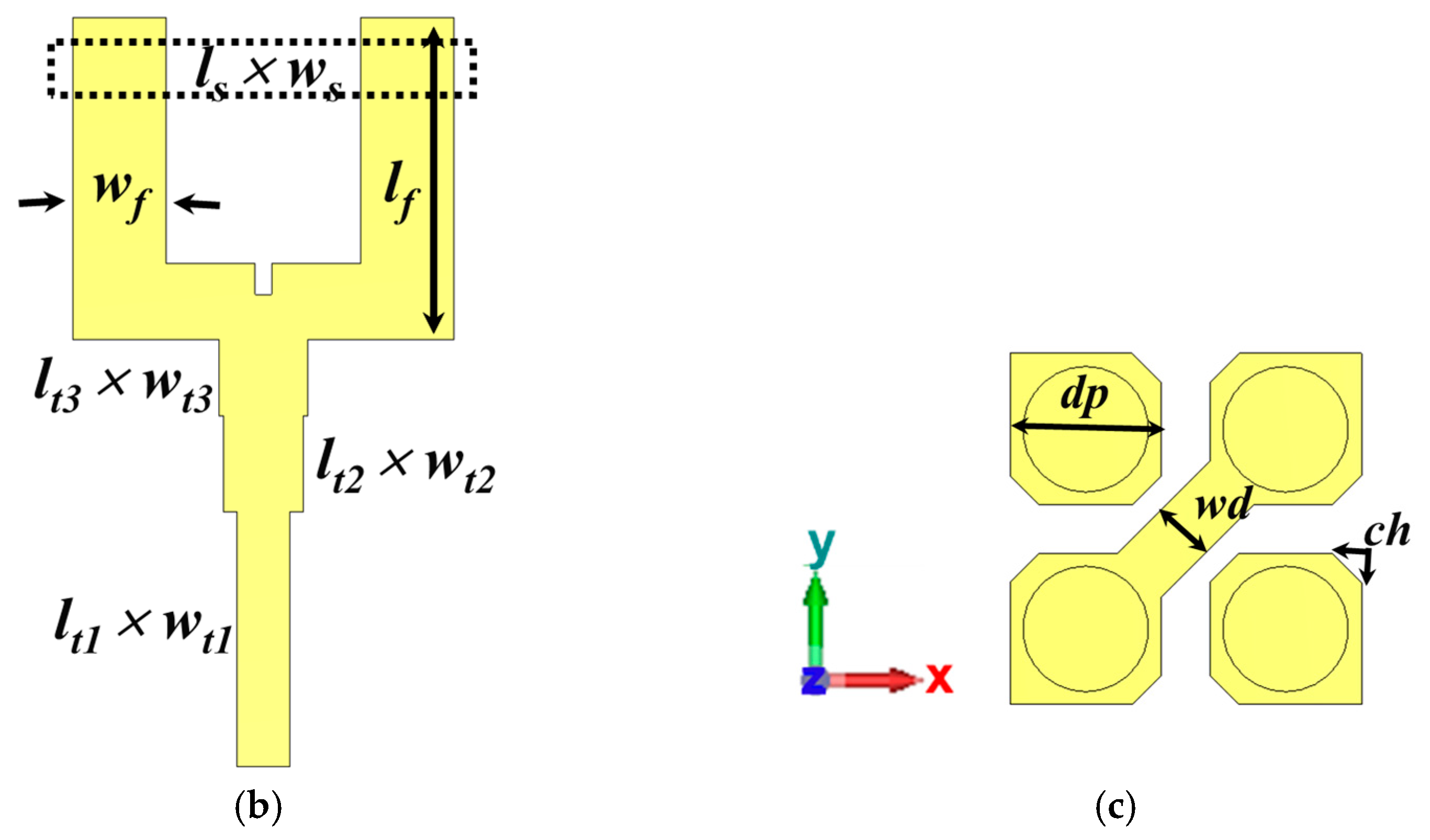
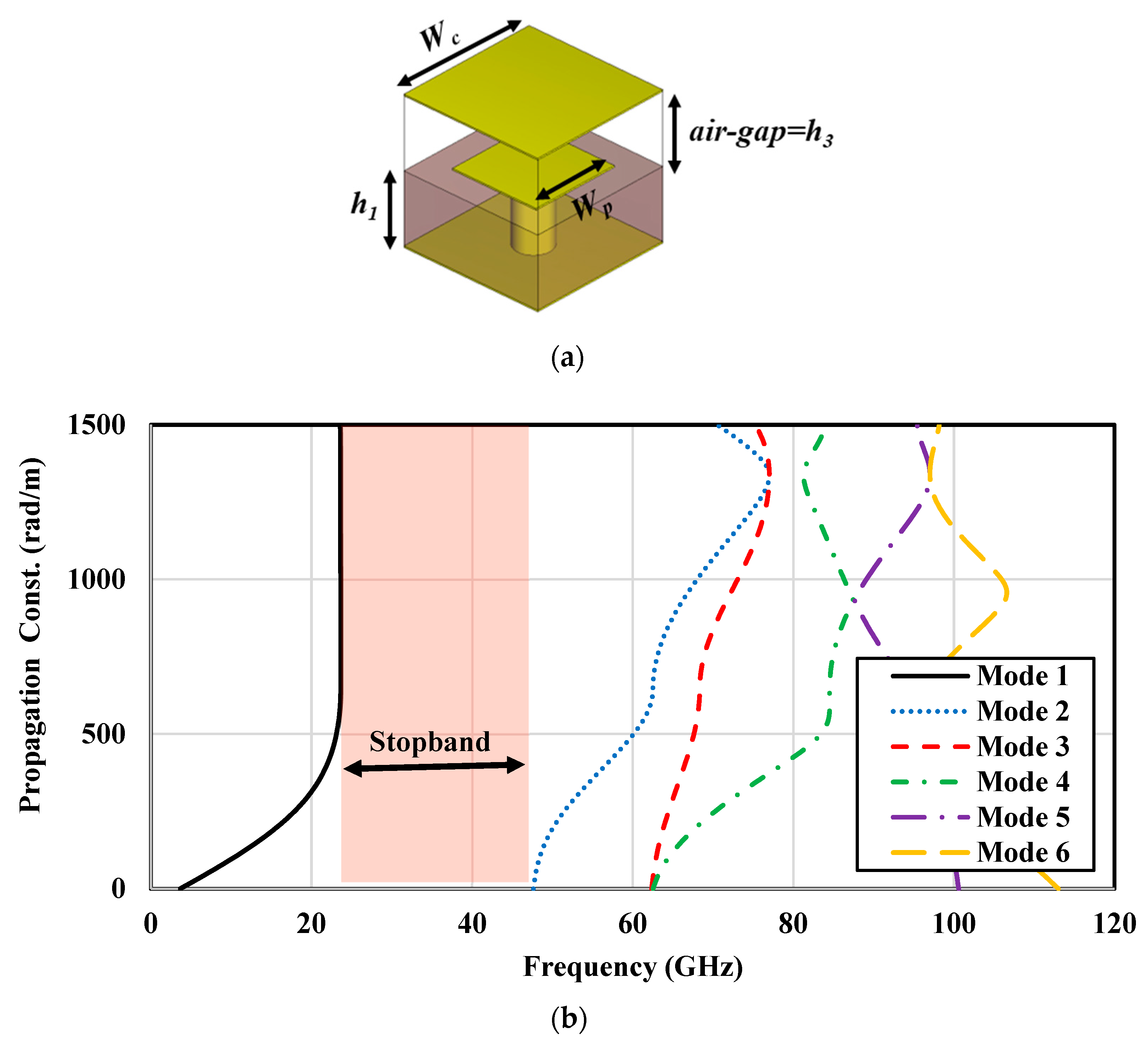
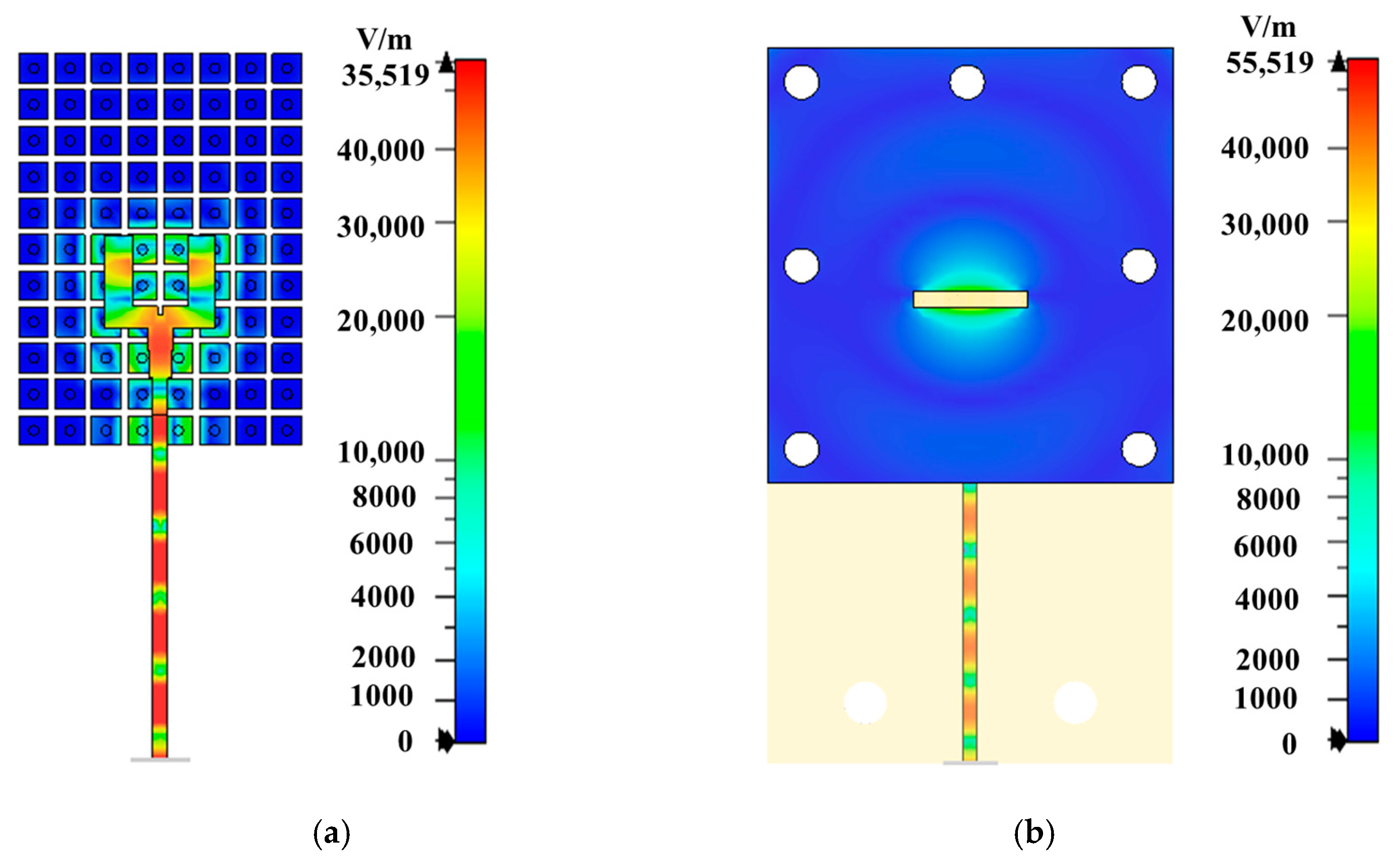


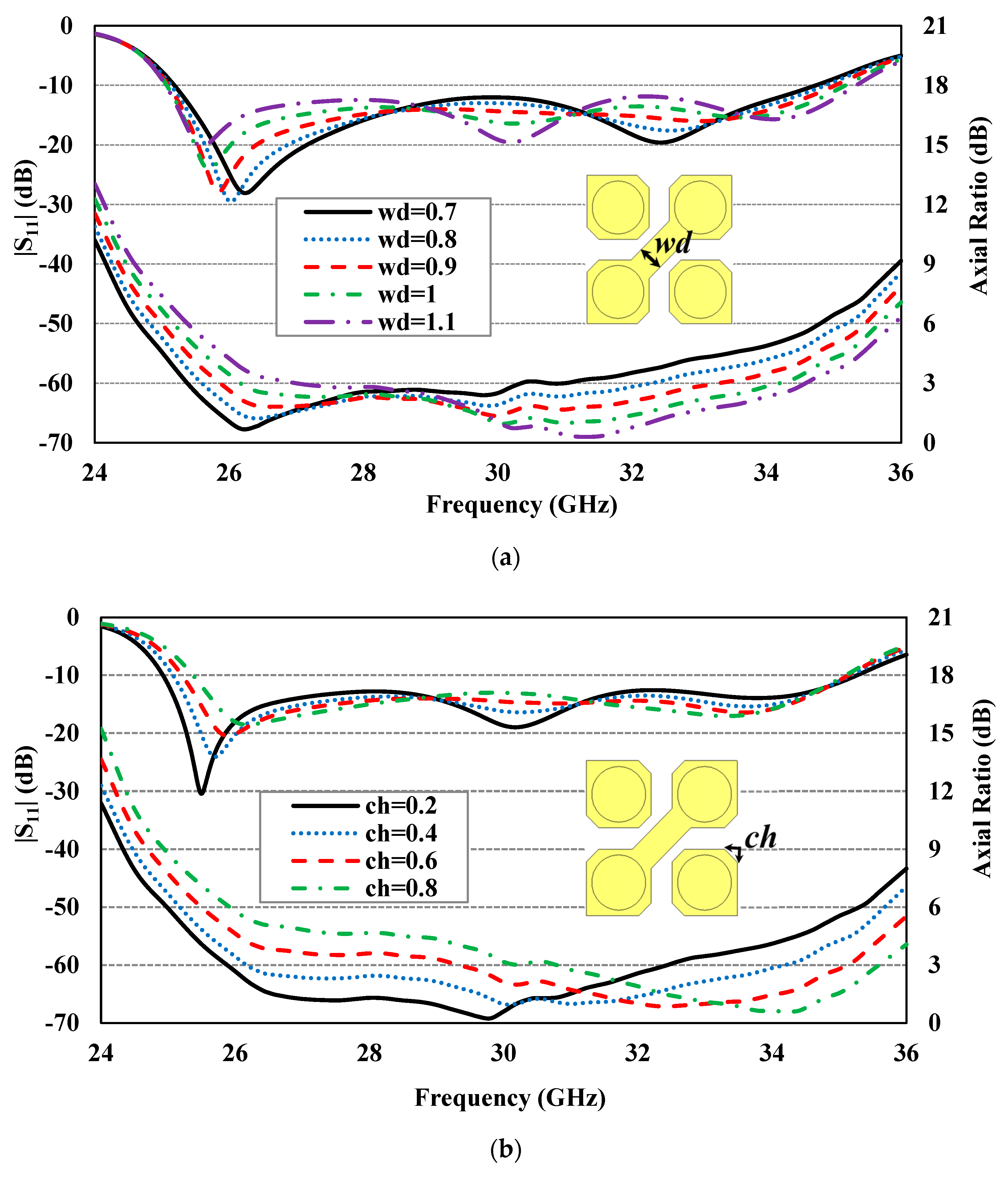




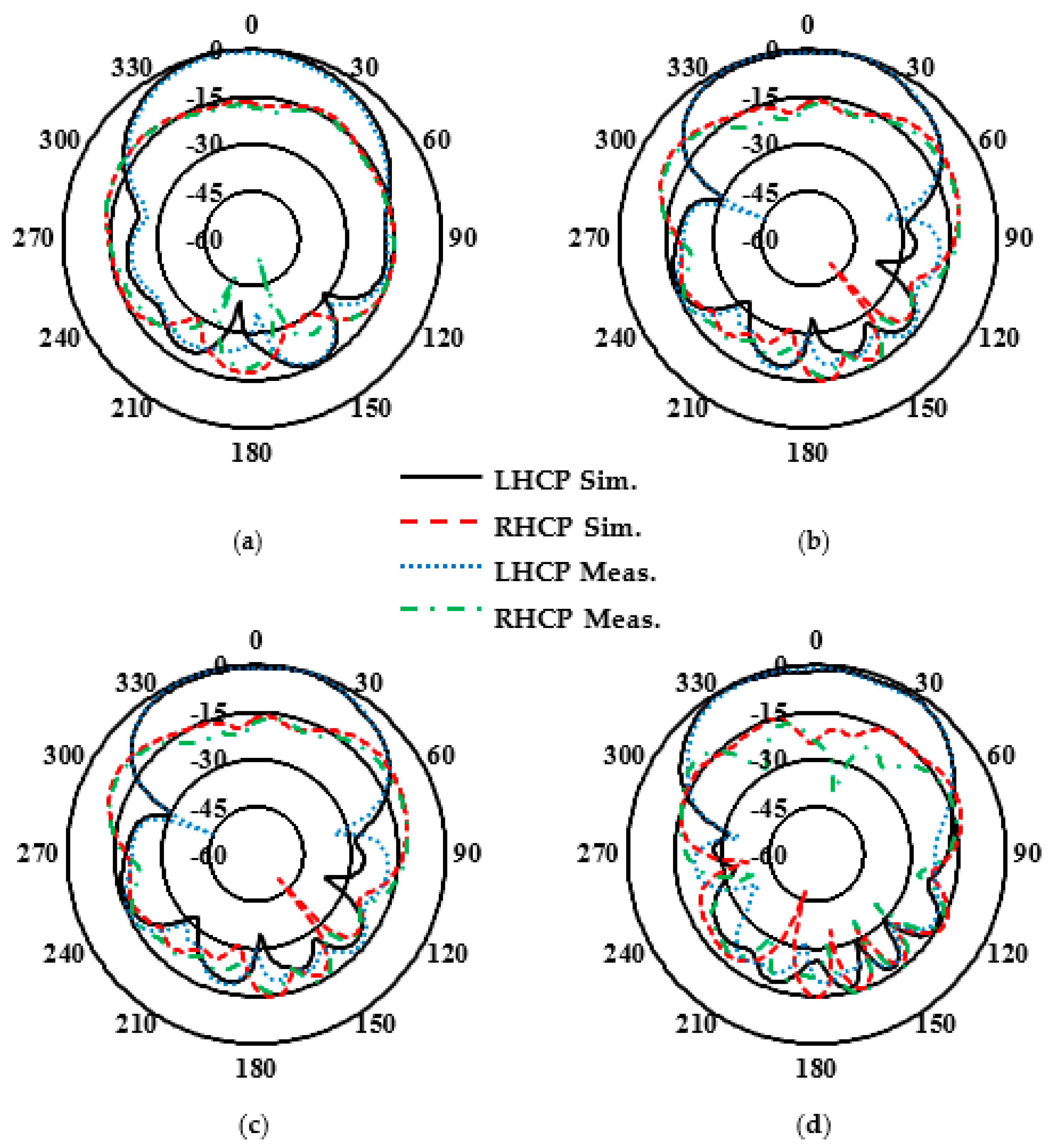
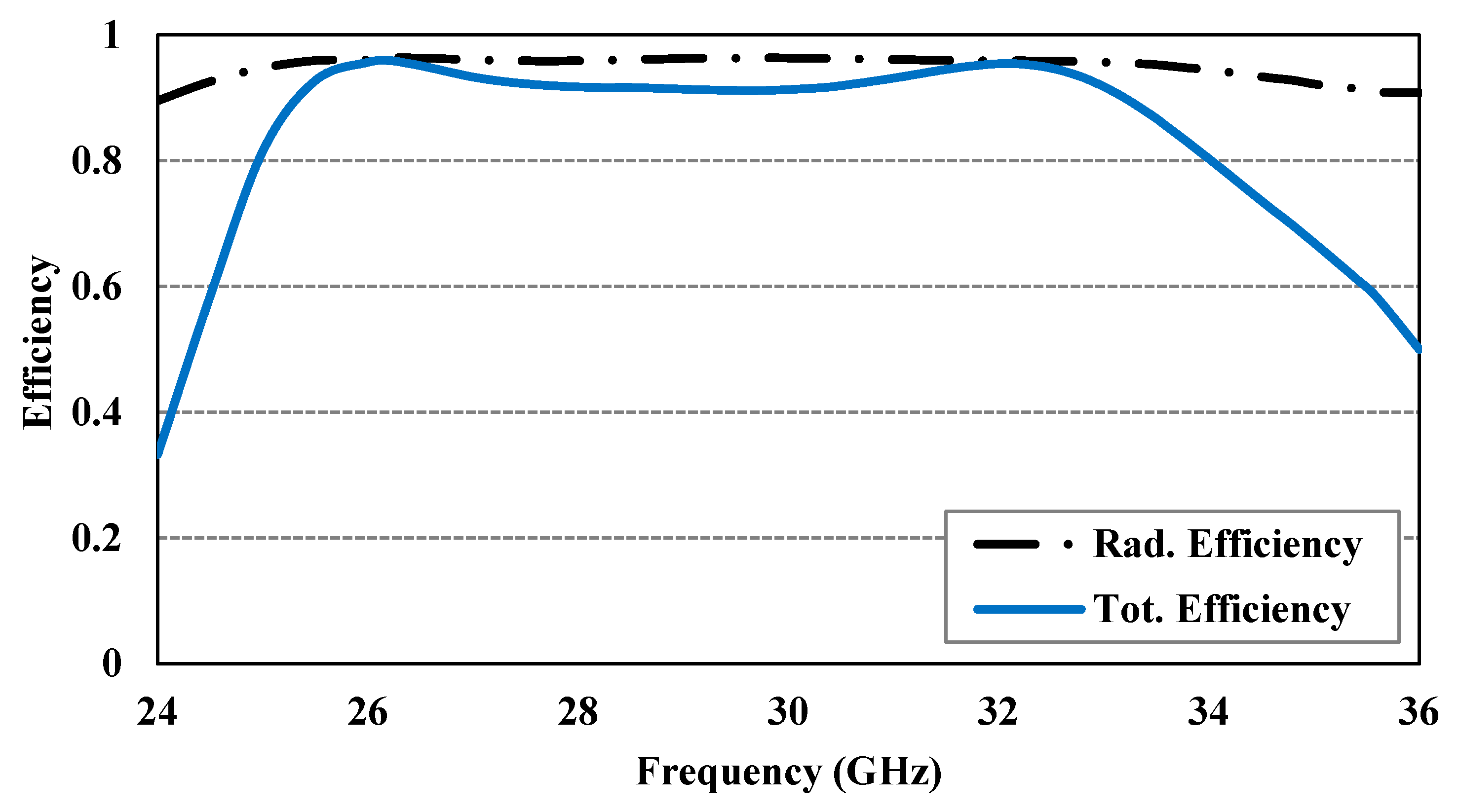
| Parameters | h1 | h2 | h3 | hm | ls | ws | wf |
| Values (mm) | 0.762 | 0.254 | 0.254 | 1.524 | 5.2 | 0.7 | 1.13 |
| Parameters | lt1 | wt1 | lt2 | wt2 | lt3 | wt3 | ts |
| Values (mm) | 3.09 | 0.63 | 1.16 | 0.96 | 0.92 | 1.1 | 0.2 |
| Parameters | dp | ch | lf | wd | Wp | Wc | Air gap |
| Values (mm) | 2.05 | 0.4 | 3.89 | 0.8 | 1.23 | 1.5 | 0.254 |
| Ref. | Frequency (GHz) | Antenna Type | Feen Network Technology | Impedance BW (−10 dB) | 3dB ARBW | Gain (dBic) |
|---|---|---|---|---|---|---|
| [12] | 28 | ME-dipole | PRGW | 24.24% | 7.4% | 10.7 |
| [17] | 34 | Spiral | PRGW | 37.2% | 23.2% | 7.2 |
| [18] | 28 | Aperture | PRGW | 15.6% | 10% | 9 |
| [29] | 28 | ME-dipole | SIW | 24.2% | 16.5% | - |
| [30] | 25 | ME-dipole | SIW | 32.6% | 12.8% | 7.8 |
| [51] | 60 | ME-dipole | SIW | 28.8% | 25.9% | 9 |
| This work | 28 | ME-dipole | PRGW | 31.0% | 24.9% | 7.8 |
Disclaimer/Publisher’s Note: The statements, opinions and data contained in all publications are solely those of the individual author(s) and contributor(s) and not of MDPI and/or the editor(s). MDPI and/or the editor(s) disclaim responsibility for any injury to people or property resulting from any ideas, methods, instructions or products referred to in the content. |
© 2024 by the authors. Licensee MDPI, Basel, Switzerland. This article is an open access article distributed under the terms and conditions of the Creative Commons Attribution (CC BY) license (https://creativecommons.org/licenses/by/4.0/).
Share and Cite
Mousavirazi, Z.; Ali, M.M.M.; PourMohammadi, P.; Fei, P.; Denidni, T.A. High-Performance CP Magneto-Electric Dipole Antenna Fed by Printed Ridge Gap Waveguide at Millimeter-Wave. Sensors 2024, 24, 8183. https://doi.org/10.3390/s24248183
Mousavirazi Z, Ali MMM, PourMohammadi P, Fei P, Denidni TA. High-Performance CP Magneto-Electric Dipole Antenna Fed by Printed Ridge Gap Waveguide at Millimeter-Wave. Sensors. 2024; 24(24):8183. https://doi.org/10.3390/s24248183
Chicago/Turabian StyleMousavirazi, Zahra, Mohamed Mamdouh M. Ali, Peyman PourMohammadi, Peng Fei, and Tayeb A. Denidni. 2024. "High-Performance CP Magneto-Electric Dipole Antenna Fed by Printed Ridge Gap Waveguide at Millimeter-Wave" Sensors 24, no. 24: 8183. https://doi.org/10.3390/s24248183
APA StyleMousavirazi, Z., Ali, M. M. M., PourMohammadi, P., Fei, P., & Denidni, T. A. (2024). High-Performance CP Magneto-Electric Dipole Antenna Fed by Printed Ridge Gap Waveguide at Millimeter-Wave. Sensors, 24(24), 8183. https://doi.org/10.3390/s24248183






